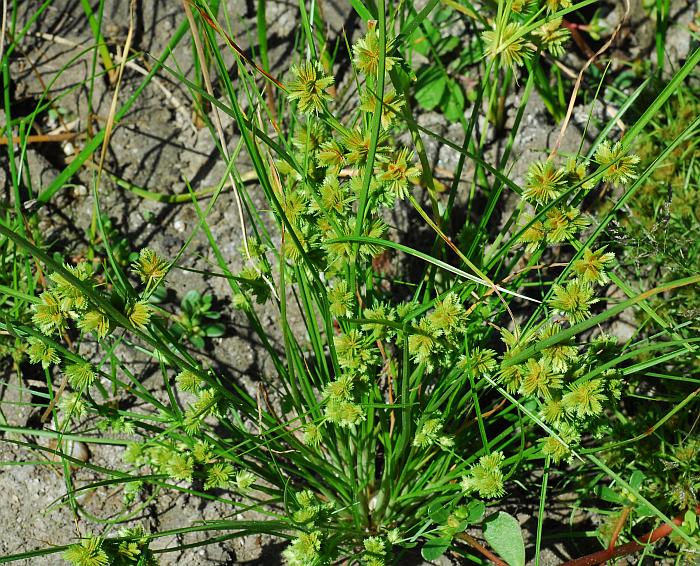Cyperus acuminatus Torr. & Hook.
Tapertip Flatsedge

Native
CC = 3
CW = -5
MOC = 62
© SRTurner
Cyperus acuminatus Torr. & Hook.Tapertip Flatsedge | |
 |
Native CC = 3 CW = -5 MOC = 62 |
© SRTurner |
|
Family - Cyperaceae Habit - Annual sedge, tufted, lacking rhizomes and tubers.
Stem - Aerial stems 5-45 cm long, bluntly trigonous, smooth or slightly roughened near the tip. Leaves - Grasslike, the blades 4-25 cm long, 1.0-2.5 mm wide, sometimes folded longitudinally and thus appearing narrower, shorter than to about as long as the stems.
Inflorescences - Irregularly compound umbels with 1 to several sessile spikes and usually with 1-4 primary rays, each ray smooth, branched again near the tip, the short branches ending in a sessile cluster of spikes. Bracts 3-6, mostly much longer than the rays, spreading to ascending.
Spikes - Spikes 7-17 mm long, with 10-75 spikelets, globose to hemispherical, dense, the spikelets radiating in several planes, attached immediately adjacent to one another on the axis, the spikelet bases densely overlapping such that basal portions usually are not visible when fresh.
Spikelets - Spikelets 3-7 mm long, broadly ovate, rounded at the tip, strongly flattened in cross-section, with 8-30 florets, the fruits and scales shed successively from the base to the tip, leaving the persistent axis. Spikelet axis not winged. Spikelet scales 1.3-2.0 mm long, strongly overlapping, appressed, narrowly oblong-elliptic to nearly linear, strongly folded around the fruit, more or less rounded to 3-angled along the back, sharply pointed at the tip, the midrib extended into a spreading to recurved point, with 3 nerves, pale yellowish brown to reddish brown, the midrib green. Stamen 1, the anther 0.5-0.7 mm long. Stigmas 3.
Fruits - Achenes 0.6-1.0 mm long, elliptic in outline, 3-angled in cross-section, the surface finely pebbled, brown, shiny, somewhat iridescent. Flowering - June - October. Habitat - Pond margins, sloughs, moist depressions of glades, roadsides, railroads, ditches, fields, moist open areas. Origin - Native to the U.S. Lookalikes - Other species of Cyperus, especially C. squarrosus. Other info. - This species of flat sedge is found in numerous counties scattered throughout much of Missouri, and is also present, though not necessarily common, in most states within the continental U.S. It is one of the more easily recognized species of Cyperus, having flat spikelets arranged in small stacks in several planes. The scale tips are distinctly spreading or recurved tips, making the spikelets appear almost like tiny sprockets. The scales are three-nerved, in contrast to those of C. squarrosus, which have 5 or more nerves. Photographs taken on the Missouri River floodplain near I-70, St. Louis County, MO 9-28-2017 (SRTurner). |